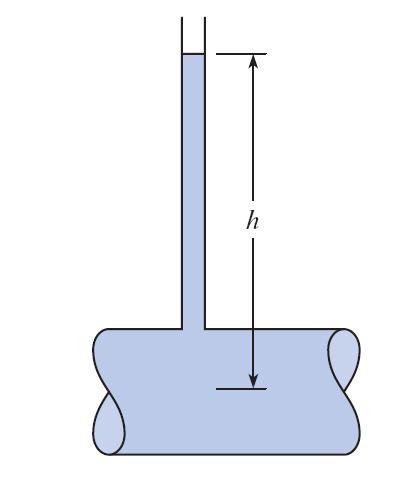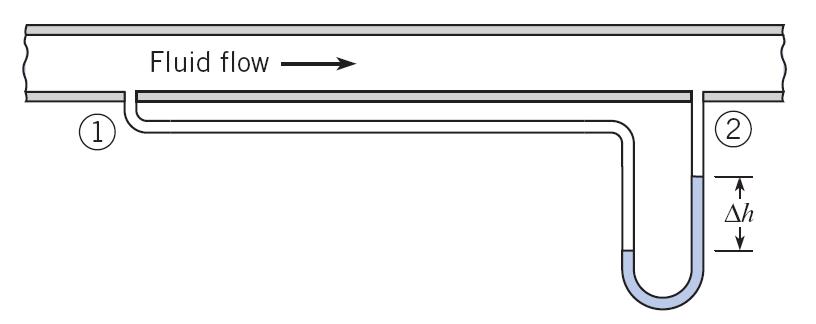Site pages
Current course
Participants
General
MODULE 1. FLUIDS MECHANICS
MODULE 2. PROPERTIES OF FLUIDS
MODULE 3. PRESSURE AND ITS MEASUREMENT
MODULE 4. PASCAL’S LAW
MODULE 5. PRESSURE FORCES ON PLANE AND CURVED SUR...
MODULE 6.
MODULE 7. BUOYANCY, METACENTRE AND METACENTRIC HEI...
MODULE 8. KINEMATICS OF FLUID FLOW
MODULE 9: CIRCULATION AND VORTICITY
MODULE 10.
MODULE 11.
MODULE 12, 13. FLUID DYNAMICS
MODULE 14.
MODULE 15. LAMINAR AND TURBULENT FLOW IN PIPES
MODULE 16. GENERAL EQUATION FOR HEAD LOSS-DARCY EQ...
MODULE 17.
MODULE 18. MAJOR AND MINOR HYDRAULIC LOSSES THROUG...
MODULE 19.
MODULE 20.
MODULE 21. DIMENSIONAL ANALYSIS AND SIMILITUDE
MODULE 22. INTRODUCTION TO FLUID MACHINERY
LESSON 5. PRESSURE MEASUREMENT
5.1 Atmospheric pressure

-
Atmospheric pressure is usually measured by a mercury barometer.
-
A simple barometer consists of a tube more than 760 mm (30 inch) long inserted in an open container of mercury with a closed and evacuated end at the top and open end at the bottom with mercury extending from the container up into the tube.
-
A void is produced at the top of the tube which is very nearly a perfect vacuum. Figure 2.10 below shows an example of a barometer.
-
Mercury rises in the tube to a height of approximately 760 mm (30 in.) at sea level.
-
The level of mercury will rise and fall as atmospheric pressure changes; direct reading of the mercury level gives prevailing atmospheric pressure as a pressure head (of mercury), which can be converted to pressure using the relation:
Patm = ρgh.
5.2 Piezometer tube

Ρ=γh
-
A simple vertical tube open at the top, which is attached to the system containing the liquid where the pressure (higher than atmospheric pressure) to be measured.
-
As the tube is open to the atmosphere, the pressure measured is the gauge pressure.
-
When Piezometric is used to measure the pressure it is called as monometers.
-
Monometers are classified as:
-
Simple
-
Differential
-
Micro monometers
5.3 U-tube manometer
-
One end of the U-tube is connected to the pressure that is to be measured, while the other end is left open to atmosphere.
-
The tube contains a liquid, which is called the manometric fluid, which does not mix with the fluid whose pressure is to be measured.
-
The fluid whose pressure is being measured should have a lesser density than the manometric fluid. (ρ < ρman )
-
Better for higher pressures.
-
Possible to measure pressure in gases.
-
Possible to measure pressure in gases.

-
Pressure change from 1 to 2 is γmΔh
-
Pressure change from 3 to 4 is γl
-
Pressure in pipe is Pp
0 + γm Δh - γl = Pp
5.4 Differential Manometer
-
In some cases, the different between the pressures at two different points is desired rather than the actual value of the pressure at each point.
-
A manometer to determine this pressure difference is called the differential manometer (see figure below).
-
The liquids in manometer will rise or fall as the pressure at either end (or both ends) of the tube changes.

5.5 Pressure Gauges
-
The pressure to be measured is applied to a curved tube, oval in cross section.
-
Pressure applied to the tube tends to cause the tube to straighten out, and the deflection of the end of the tube is communicated through a system of levers to a recording needle.
-
This gauge is widely used for steam and compressed gases.
-
The pressur eindicated is the difference between that communicated by the system to the external (ambient) pressure, and is usually referred to as the gauge pressure.